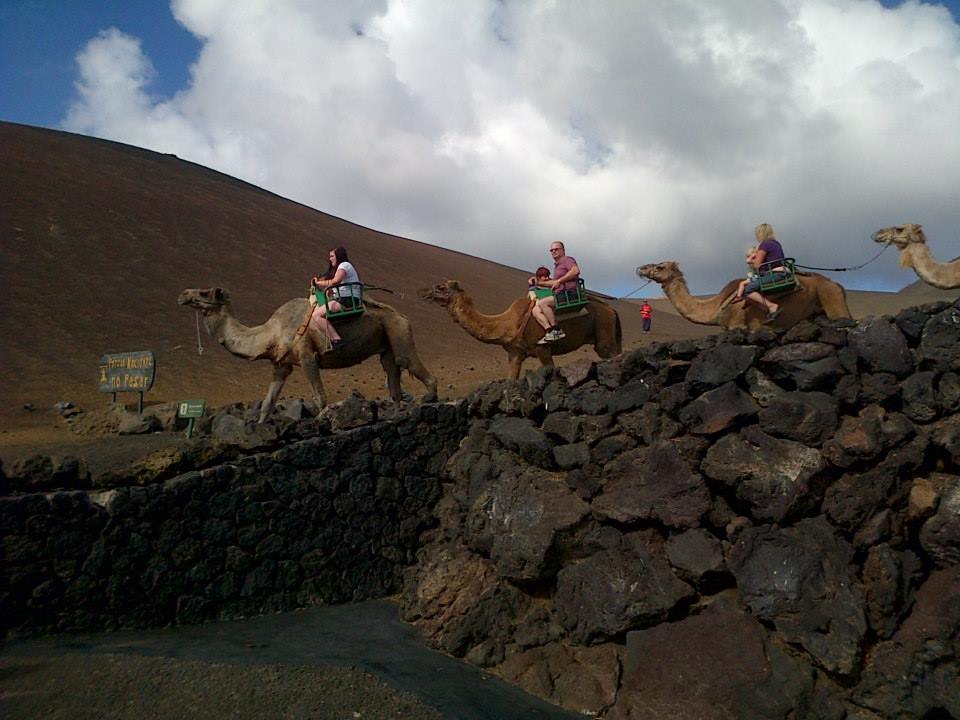As the wet, windy, and dark evenings of October in Yorkshire encroached on my friends and family back home, I couldn’t have felt as content as I did on the evening of 23rd October. There I was, bare-legged and barefoot, sitting on the sands of Playa de los Charcos, the quieter beach of the three in Costa Teguise, Lanzarote. It was a snapshot of near perfection—a simple moment shared with my daughter as we relaxed on the beach, the bleached white sands highlighting the golden tones of our tanning skin. In that moment, I felt a lot of love for Lanzarote.
I had planned this as a relaxing holiday, a change of pace from my usual active routine. But it didn’t take long to discover there’s a lot of love for Lanzarote’s adventurous side. Playa de las Cucharas, famous for windsurfing, buzzed with activity. Personally, I would have loved to try one of the cycling excursions offered by local companies, where they pick you up, hire you a bike, and guide you along scenic inland routes. A Polish family I met spoke passionately about the beaches in the south of the island, perfect for surfing and bodyboarding. These wide, sweeping beaches felt like something out of a surfer’s dream, reminiscent of the Atlantic coasts of France and Portugal.
For those exploring further afield, Lanzarote’s transport options don’t disappoint. Hiring a car is always an option, but the island’s frequent and reliable bus service makes getting around a breeze. The buses run every 30 minutes between Arrecife and Puerto del Carmen, 24 hours a day—a service that’s impressive by any standard.
Our evenings were just as magical. One night, on Playa de las Cucharas, I gazed out at the pastel hues of pinks, lilacs, and blues painted by the setting sun, punctuated by the striking black volcanic rocks edging the beach. The volcanic nature of Lanzarote is everywhere you look, a reminder of how the island’s fiery origins have shaped its unique character. It’s this blend of dramatic landscapes and mild year-round weather that makes Lanzarote such an easy choice for a winter escape. For me, it was also the perfect first trip abroad as a single parent.
I had worried that evenings might feel dull, but I needn’t have. Lanzarote’s thriving tourism industry offers plenty to keep visitors entertained without breaking the bank. In Costa Teguise alone, there are hundreds of bars and restaurants vying for attention, offering set menus for under ten euros, full English breakfasts for €2.50, and irresistible drinks deals. My favourite dining spot was Pablo’s Restaurante Canario & Internacional in the Encargado Terraza. True to its name, it served a mix of traditional and international dishes. I chose gnocchi followed by beautifully presented profiteroles, while my daughter stuck to the classic chicken nuggets and chips, rounded off with chocolate ice cream. The Romanesque décor—walls covered in leaves, faux-stone statues, and columns between tables—added a whimsical charm. The cherry on top? The unexpected delight of easy-listening tunes played live on a grand piano.
Lanzarote, like the other Canary Islands, has been shaped by tourism, catering to visitors from Spain, the UK, Germany, and beyond. But what sets Lanzarote apart is the legacy of César Manrique. This visionary artist foresaw how tourism might impact the island’s culture and fought to preserve its natural beauty and traditional architecture. Thanks to his efforts, buildings remain low-rise and harmoniously painted in white and beige, while unsightly billboards and overhead cables are nowhere to be seen. His influence is evident in the island’s attractions, showcasing the pride Lanzaroteans feel for their unique home. It’s impossible not to feel a lot of love for Lanzarote’s charm and the care its people have taken to preserve it.
To dive deeper into the island’s treasures, I booked a south short tour with Last Minute Tours. At €36 for an adult and child, it included a visit to Timanfaya National Park, a camel ride, and a stop at one of Lanzarote’s wineries. The tour was a highlight, demonstrating the volcanic essence of the island. At Timanfaya, guides let us hold gravel heated by the volcanic ground—it was so hot we had to drop it almost immediately. Food in the restaurant is even cooked over volcanic heat. To protect the park’s beauty, visitors can only view its striking craters by coach. The dramatic reds and oranges of the ash fields were unforgettable. For the adventurous, camel rides offered a unique way to experience the landscape. The nearby village of Yaiza relies on the income generated by these camels, and strict regulations ensure the animals are well cared for.
The wine region was another revelation. The arid, volcanic terrain seems inhospitable, yet the locals have mastered it. Small craters dug into the ash reveal fertile soil, with vines nestled within and protected by stone walls. This ingenious technique produces unique wines, a testament to the resilience of Lanzarote’s people. While I didn’t love the dry Malvasia Seco, the sweet, peachy Moscatel stole the show.
As a solo parent, safety was a priority, and I felt completely at ease throughout our stay. The islanders were welcoming and kind, especially to children. Costa Teguise’s parks kept my daughter entertained when she’d had enough of the pool, giving me a chance to relax even more.
Lanzarote truly has it all: sun, sand, adventure, and an undeniable charm. If you’re looking to escape the dark winters of Northern Europe while enjoying breathtaking landscapes and a lot of love for Lanzarote’s warm hospitality, this island should be at the top of your list.

